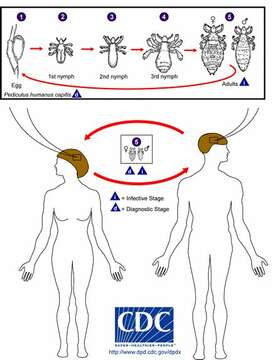Life cycle of the Head Louse (Pediculus humanus capitis), an ectparasite of humans

Description:
Life cycle of the Head Louse (Pediculus humanus capitis), an ectparasite of humans
The life cycle of the Head Louse (Pediculis humanus capitis) has three stages: egg, nymph, and adult.
Eggs: Nits are Head Lice eggs. They are hard to see and are often mistaken for dandruff or hair spray droplets. Nits are laid by the adult female and are cemented at the base of the hair shaft nearest the scalp (1). They are 0.8 mm by 0.3 mm, oval and usually yellow to white. Nits take about 1 week to hatch (range 6 to 9 days). Viable eggs are usually located within 6 mm of the scalp.
Nymphs: The egg hatches to release a nymph (2). The nit shell then becomes a more visible dull yellow and remains attached to the hair shaft. The nymph looks like an adult head louse, but is about the size of a pinhead. Nymphs mature after three molts (3, 4) and become adults about 7 days after hatching.
Adults: The adult louse is about the size of a sesame seed, has 6 legs (each with claws), and is tan to grayish-white (5). In persons with dark hair, the adult louse will appear darker. Females are usually larger than males and can lay up to 8 nits per day. Adult lice can live up to 30 days on a person’s head. To survive , adult lice need to feed on blood several times daily. Without blood meals, the louse will die within 1 to 2 days off the host.
From Centers for Disease Control Parasites and Health website.
Included On The Following Pages:
- Life (creatures)
- Cellular (cellular organisms)
- Eukaryota (eukaryotes)
- Opisthokonta (opisthokonts)
- Metazoa (Animal)
- Bilateria
- Protostomia (protostomes)
- Ecdysozoa (ecdysozoans)
- Arthropoda (arthropods)
- Pancrustacea
- Hexapoda (hexapods)
- Insecta (insects)
- Pterygota (winged insects)
- Neoptera (neopteran)
- Paraneoptera
- Psocodea (bark lice, book lice and true lice)
- Troctomorpha (book louse)
- Phthiraptera (lice)
- Anoplura (sucking louse)
- Pediculidae (primate body lice)
- Pediculus
- Pediculus humanus (human body louse)
- Panarthropoda
This image is not featured in any collections.
Source Information
- license
- cc-by-nc-sa-3.0
- copyright
- Centers for Disease Control/Division of Parasitic Diseases and Malaria
- publisher
- Shapiro, Leo
- photographer
- Centers for Disease Control/Division of Parasitic Diseases and Malaria
- provider
- EOL Rapid Response Team
- original
- original media file
- visit source
- partner site
- EOL staff
- ID


